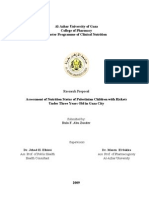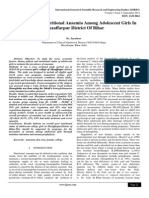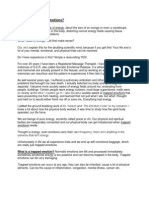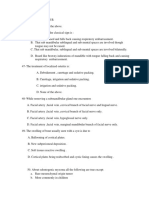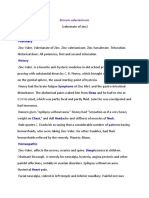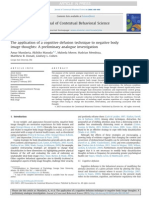Jurnal Anemia
Jurnal Anemia
Uploaded by
marselyagCopyright:
Available Formats
Jurnal Anemia
Jurnal Anemia
Uploaded by
marselyagCopyright
Available Formats
Share this document
Did you find this document useful?
Is this content inappropriate?
Copyright:
Available Formats
Jurnal Anemia
Jurnal Anemia
Uploaded by
marselyagCopyright:
Available Formats
INTERNATIONAL JOURNAL Of ACADEMIC RESEARCH
Vol. 3. No. 1. January, 2011, Part II
EPIDEMIOLOGY OF IRON DEFICIENCY ANAEMIA: EFFECT ON PHYSICAL GROWTH IN PRIMARY SCHOOL CHILDREN, THE IMPORTANCE OF HOOKWORMS
Dr. Alaa Ali , Dr. Gihan A Fathy , Dr. Hanan A Fathy , MD. Nagwa Abd El-Ghaffar
1 2 1 1 2 3
Child Health Department (NRC), National Centre for Radiation Research and Technology, 3 Department of Clinical And Chemical Pathology (NRC) (EGYPT)
ABSTRACT Anemia is estimated to affect almost one-half of school-age Children in the developing countries. The school years are an Opportune time to intervene and interventions must be based on sound epidemiologic understanding of the problem in this age group. We report on the distribution of iron deficiency and anemia across Age, sex, anthropometric indexes, and parasitic infections in a Representative sample of 400 schoolchildren from Elminopheia district, Egypt. Iron status was assessed by haemoglobin, and serum ferritin from a venous blood sample. The prevalence of iron deficiency in our study was 65% and 55% of anaemia was associated with iron deficiency. An iron deficient child was defined as every Child with either serum iron less than 50 g/d, or Serum TIBC more than 400 g/dL. In our study iron deficiency was more common in children who did not usually have breakfast as opposed to those who did. Children with current parasitic infestations showed a higher frequency of iron deficiency compared to children free from parasitic infestations. Pallor occurred more commonly in iron deficient children. Children with a history of cardiac diseases, pulmonary diseases, rheumatic diseases, renal failure or tumours had significantly heigher frequency of iron deficiency than children who did not. There were no differences between children with parasitic infestation and children without parasitic infestation as regards age, gender, weight, height and BMI. We conclude that Iron deficient group are more prone to weight retardation. Iron deficiency is more common in children who do not consume breakfast, have chronic disease or have parasitic infestation Key words: iron deficiency, physical growth, anaemia, Hookworms, schoolchildren. 1. INTRODUCTION Iron deficiency is a significant global problem. It is one of the major public health concern in preschool children and pregnant women in the developing countries. Many studies have examined these two at-risk groups; there is a paucity of data on anemia in preschool children living in developing countries (1). Iron deficiency anaemia during pregnancy has been associated with Increased risk for low birth weight, preterm delivery, and perinatal mortality. Iron deficiency is the commonest form of malnutrition worldwide and according to the World Health organization affects 43% of the worlds children (2). Deficiency may be due to inadequate dietary intake of iron, low level of absorption because of small bowel pathology, increased physiological requirements during rapid growth in infancy and adolescence and chronic blood loss usually from the gastrointestinal or urinary tracts or because of menorrhagia in adolescent girls (3).we observed a positive correlation between serum ferritin (SF) and haemoglobin (Hb) concentrations, suggesting that a significant proportion of anaemia cases might be related to iron deficiency (4). Another study showed that higher iron intake is associated with a decreased prevalence of anaemia. However, only one-third of the incidence of anaemia in this study was attributed to iron deficiency suggesting the existence of other causal factors (5). The aim of the study: This study was undertaken to estimate the prevalence of anaemia and iron deficiency among primary schoolchildren in elmenopheyia, Egypt, what are the causes and its effect on general growth. 2. SUBJECTS AND METHODS This study was conducted in Elminophyia region as a pilot cross sectional observational study. 500 pupils were enrolled from the primary schools and aged between 6 and 12 years old. All were recruited for this study with parents consent. 100 children dismissed and refusedfor blood venipuncture. Socio demographic data werecollected with questionnaire filled out by the parents. The socio economic status was defined by the following parameters: the family income, the parent educational status, the number of family members and the working status of the parents. All children included in this study were subjected to: 1) History taking: Laying stress on: - Dietetic history.
B a k u , A z e r b a i j a n | 495
INTERNATIONAL JOURNAL Of ACADEMIC RESEARCH
Vol. 3. No.1. January, 2011, Part II
- History of parasitic infestation (by asking about infestation with parasites or taking any antihelminthics treatment now or before). - Any Chronic diseases (as renal failure, cardiac diseases, pulmonary diseases, rheumatic diseases or tumours). 2) Examination: Complete clinical examination laying stress on: General anthropometric measures including: Height, weight, and BMI: and all the results were compared with the standard curves for age according to the WHO (2006) (6). Pulse and blood pressure measurement, described as normal or abnormal for age according to Robert D (7). Relevant clinical findings as: Pallor, jaundice, Fatigue. 3) Laboratory investigations: Sampling : We obtained 3 samples of stool from different locations of the specimen. From each child, 2 ml of venous blood sample was collected using a syringe for measurement of hemoglobin concentration and serum iron. 1. Hemoglobin concentration: Directly measured using a spectrophotometer (Hemoglobin meter). (8) 2. Stool examination: By ordinary light microscope to detect any parasites which could be the cause of anemia. 3. Iron and total iron binding capacity: Was done by clorometric kits produced by STANBIO Company (United States of America). 3. THE RESULTS Our results are illustrated in the following tables. 400 primary school Children were studied over the period from January 2008 to june 2009: 232 girls (58%) and 168 boys (42%) Table 1. The clinical and laboratory parameters of the studied children. Parameters Age (years) Weight (Kg) Height (cm) 2 BMI (Kg/m ) Systolic blood pressure (mmHg) Diastolic blood pressure (mmHg) Pulse (bpm) Hemoglobin (g/dl) Serum iron (g/dl) Serum TIBC (g/dl) Mean SD 9.0 7.6 25.1 6.3 128.1 18.6 24.5 5.8 90.5 10.2 64.7 5.9 80.6 4.4 9.8 4.6 70.4 22.9 439.62 129.7
This table shows the range, mean value and standard deviation for tested parameters in our study population. Table 2. The frequency of the studied parameters in the whole studied children Parameters Breakfast intake History of parasitic infestation History of chronic diseases and drug intake Pallor Presence of parasitic infestations in stools Yes (positive) 168 (42%) 140 (35%) 28(7%) 140 (35%) 180(45%) No (negative) 232 (58%) 260(65%) 372 (93%) 260(65%) 220(55%)
This table illustrates the qualitative parameters of our study population. A history of parasitic infestation was present in 35% of our study population, whilst presence of a parasite in stools was documented in 45%. The majority of our study population were not pale (65%).
496 | www.ijar.lit.az
INTERNATIONAL JOURNAL Of ACADEMIC RESEARCH
Vol. 3. No. 1. January, 2011, Part II
Table 3. The frequency of iron deficiency in the studied children Items Iron deficiency Non iron deficiency Frequency 220 180 % 55 45
The prevalence of iron deficiency in our study was 56%. An iron deficient child was defined as every child with either serum iron less than 50 g/d, or Serum TIBC more than 400 g/dL in our study. Table 4. Comparison of the various clinical and laboratory parameters between iron and non iron deficient children (MeanSD). Parameters Age (years) Weight (kg) Height (cm) 2 BMI (Kg/m ) Hemoglobin (g/dl) Serum iron(g/dl) Serum TIBC (g/dl) Iron deficiency 9.0 4.7 25.8 4.8 127.3 17.2 23.26.4 9.6 3.2 40.8 10.2 476.3 99.7 Non iron deficiency 8.9 5.6 26.01 4.3 127.9 18.1 25.5 7.0 10.2 3.1 89.817.6 354.9 78.4 P >0.05 <0.05 >0.05 <0.05 <0.01 <0.001 <0.001
Iron deficiency was found in 220 children. There were no statistically significant differences between iron deficient and non iron deficient groups as regards age, gender or height (P > 0.05). Iron deficient children had significantly lower values for weight (P < 0.01), BMI (P < 0.01) and hemoglobin concentration (P<0.01) than non iron deficient children. Table 5. Comparison between iron deficient and non iron deficient children as regards possible contributing factors to iron deficiency
Items Iron deficiency Number % 64 16 156 48 172 20 200 120 100 39 12 43 5 50 30 25 Non iron deficiency Number % 104 26 76 92 88 8 172 60 120 19 23 22 2 43 <0.001 15 30 <0.001 P
Breakfast No breakfast History of parasitic infestation No history of parasitic infestation History of chronic conditions & drug intake No history of chronic conditions & drug intake Presence of Parasitic infestation in stools Absence of Parasitic infestation in stools
<0.01 >0.05
This table shows that iron deficiency was more common in children who did not usually have breakfast as opposed to those who did. This difference was statistically significant (P < 0.01). There were no statistically significant differences between the iron deficient and non iron deficient children as regards the history of parasitic infestation (P > 0.05). Children with a history of cardiac diseases, pulmonary diseases, rheumatic diseases, renal failure or tumours had significantly higher frequency of iron deficiency than children who did not (P < 0.01). Children with current parasitic infestations showed a higher frequency of iron deficiency compared to children free from parasitic infestations. This difference was highly statistically significant (P < 0.001). Table 7. The relationship between iron deficiency and pallor. Items Presence of pallor Absence of pallor Iron deficiency Number % 116 29 104 26 Non iron deficiency Number % 24 6 156 39 P
<0.001
Pallor occurred more commonly in iron deficient children. This difference was statistically significant (P < 0.01).
B a k u , A z e r b a i j a n | 497
INTERNATIONAL JOURNAL Of ACADEMIC RESEARCH
Vol. 3. No.1. January, 2011, Part II
Table 8. Comparison between children with and without parasitic infestation as regards various clinical and laboratory parameters (MeanSD) Parameters Age (years) Weight (Kg) Hemoglobin (g/dl) Serum iron (g/dl) Serum TIBC (g/dl) Parasitic infestation 9.1 3.2 25.64.5 9.53.8 45.912.6 467.891.6 Absence of parasitic infestation 8.92.4 26.013.8 10.42.4 95.413.9 342.987.6 P >0.05 >0.05 <0.001 <0.001 <0.001
There were no statistically significant differences between children with parasitic infestation and children without parasitic infestation as regards age, gender, weight, height and BMI (P >0.05). 4. DISCUSSION Iron deficiency anemia is one of the worlds most widespread health problems especially among children: approximately 40 percent of children are anemic across various African and Asian settings (9). Iron deficiency anemia leads to weakness, poor physical growth, and a compromised immune system decreasing the ability to fight infections and increasing morbidity and is also thought to impair cognitive performance and delay psychomotor development. Iron deficiency is the most common form of nutritional deficiency in childhood, affecting all socio-economic levels of society (10). It is a major public health concern in preschool children and pregnant women in the developing countries. Many studies have examined these two at-risk groups; there is a paucity of data on anemia in school children living in developing countries (11). The aim of this work was to assess the prevalence of iron deficiency in school children in EL-Minopheyia district, its probable Causes and its effect on general growth In order to achieve these objectives, this work was conducted on 400 children between 7-12 years in primary schools in EL Minopeyia district governorate, chosen as a consecutive random sample. All children were subjected to full history taking, anthropometric parameters, and stool examination, estimation of hemoglobin concentration, serum iron, and serum iron binding capacity. In our study the prevalence of iron deficiency was 65% among the primary school children in El Minopheyia district, and 55% of them were also anemic (IDA) . Our study results concur with the WHO (12) data on global rates of iron deficiency in developing countries that show 46% of children of school age are iron deficient. Also Bobonis et al. (2006)(13) reported that studies performed in developing countries such as India have demonstrated values around 69% for the prevalence of iron deficiency in the 2-6 age group. Olney and Kariger (2007)(14) measured serum iron in 771 child in Pemba, Zanzibar, Tanzania, and about 77% of them were iron deficient. Our findings are similar to the results of the survey conducted by El-Zanaty et al. (2005)(15) on Egyptian school children in Alexandria governorate, which showed that about 30.3% of them were iron deficient anemics. Also our results agree with the results of a study conducted by Aboussaleh et al. (2004)(16) on 306 pupils from seven primary schools in the province of Kenitra in Morocco. They found that more than 30% of these children had iron deficiency anemia. Prevalence did not differ by sex. On the other hand, a study conducted by Manzoor et al. (2003)(17) on 1100 primary school children in the province of Lahore in Pakistan, revealed that the prevalence of iron deficiency anemia was 10.5%. This is also in accordance with Soliman et al. (2009)(18) who reported that iron deficiency anemia IDA during the first 2 years of life significantly impairs growth, and there is a significantly correlation between growth velocity (GV) and serum ferritin concentration. The majority of these studies are in agreement with our study results, since all these studies were done in developing countries with a similar environment and causes of iron deficiency. Defference in between studies could be contributed to different age groups studied and methodology of assessment of iron deficieny anemia. The high prevalence of iron deficiency among this age group is explained by the increased needs for iron due to rapid growth, low intake of iron-rich foods, inappropriate dietary choices, intestinal parasitic infestation and frequent consumption of tea with meals, all or in various combinations (19). The children were classified according to the results of serum iron into iron deficient and non iron deficient groups. Our study showed that iron deficient children had lower weights and BMI than non-iron deficient children. Similarly iron deficient children with anemia had significantly lower weight and BMI than deficient children without anemia. In our study there were no statistically significant differences between the iron deficient and non-iron deficient groups as regards the height. Waterlow (20) reported that, etiology of linear growth retardation is multifactorial but has been explained by three major factors: poor nutrition, high levels of infection and problematic mother-infant interaction, which is closely related to the socio-economic status of the family. This is in accordance with the findings of Ramakrishnan et al. (2004)(21)who reported that there is no statistically significant effect of iron supplementation on height-for-age in children.
498 | www.ijar.lit.az
INTERNATIONAL JOURNAL Of ACADEMIC RESEARCH
Vol. 3. No. 1. January, 2011, Part II
This is explained by Beckett et al. (2000)(22), who reported that observational studies have postulated a positive effect on physical growth due to indirect effects of iron supplementation improvement in immunity leading to decreased incidence of infections, and improvement in appetite and consequently the intake of energy. Most of studies are from developing countries, that have marginal food availability and poor feeding practices, where improvement in the appetite and activity levels of the child may not translate in to increased energy intake, and therefore enhanced height gain. In our study parasitic infestation was present in 35% of the children; Ascaris, Oxyuris, Entamoeba histolytica, and Giardia lamblia were the most frequent parasites. Children with iron deficiency had a significantly higher frequency of parasitic infestation. Similarly, iron deficiency anemic (IDA) children had a significantly higher frequency of parasitic infestations compared to iron deficiency non-anemic (IDNA) children. This agrees with the results of a study conducted by Magbool et al. (2007)(23) on 978 school children in the villages of district Skardu, Pakistan, under school health care program 2004. It revealed that the prevalence of intestinal parasites was 54.91%; Ascaris, Giardia lamblia, Entamoeba histolytica, and Oxyuris were the most frequent forms. They found an associatation between the intestinal parasitic infestations and iron deficiency anemia in school children. Our results also agree with the results of a survey conducted by Wani et al. (2007)(24) on 514 schoolchildren enrolled in various schools in Srinagar City, Kashmir, India. They found that 46.7% of students had one or more parasites, and there was a relation between iron deficiency anemia and hookworm infestations. This is explained by the fact that blood loss (mostly occult bleeding), reduced appetite, impaired digestion, and malabsorption may be the causes of poor iron status and iron deficiency anemia that are frequently observed in children suffering from intestinal parasitic infestations(25) . Our study showed that iron deficiency was more common in children who did not usually have breakfast as opposed to those who did. Similarly missing the breakfast meal was significantly more common in the iron deficient anemic (IDA) children than in iron deficient non-anemic (IDNA) children. This is explained by Ramzy (2000)(26), who reported that children who ate breakfast were two to five times more likely to consume at least two-thirds of the recommended amounts of most vitamins and minerals, including iron. Intakes of vitamins and minerals, including zinc, calcium, and folic acid, were much higher among the breakfast eaters, while fat consumption was lower. The nutrients missed when children skip breakfast are rarely recouped during other meals. In our study there were no statistically significant differences between the iron deficient and non-iron deficient groups as regards the height. In our study Pallor occurred more commonly in iron deficient children. This difference was statistically significant (P < 0.01). 5. CONCLUSIONS Iron deficient group are more prone to weight retardation. Iron deficiency is more common in children who do not consume breakfast, have chronic disease or have parasitic infestation. Verster and Van-der-pols (2004)(27)reported that the prevalence of iron deficiency in school age in the Eastern Mediterranean region ranged from around 20% in Jordan, to more than 60% in parts of Egypt and Oman. 6. RECOMMENDATIONS In light of this study we recommend the following : I- Arrangement of campaigns through the mass media to highlight the hazards of iron deficiency and iron deficiency anemia and to explain the ways that can reduce the disease. II- Implementing a well baby clinic in all health facilities for : - Early detection and treatment of iron deficiency anemia. - Early detection and treatment of parasitic infestation. - Encouraging the ingestion of breakfast. III- Fortification of food with iron to reduce the magnitude of the problem in Egypt. REFERENCES 1. 2. 3. Leenstra T., Oloo A.J., Kariuki S.K., Kurtis J.D., and Kager P.A. (2004): "Prevalence and severity of anemia and iron deficiency in school girls in western Kenya". European Journal of Clinical Nutrition; 58: 681-21. De Maeyer E. & Adiels-Teasman M. The prevalence of anaemia in the world. World Health Statistical Quarterly 1985; 38, 302316. World Health Organisation/United Nations University/UNICEF (2001) Iron Deficiency Anaemia, Assessment, Prevention and Control: a Guide for Programme Managers. WHO, Geneva, Switzerland
B a k u , A z e r b a i j a n | 499
INTERNATIONAL JOURNAL Of ACADEMIC RESEARCH
4. 5. 6. 7. 8. 9. 10. 11. 12. 13. 14. 15. 16. 17. 18. 19. 20. 21. 22. 23. 24. 25. 26. 27.
Vol. 3. No.1. January, 2011, Part II
Ministry for the Public health. 2001, deficiency of micronutrients: Extent of the Problem and strategies of fight Programs of fight against the disorders due to the deficiencies in micronutriments. Morocco. Aboussaleh Y., Ahami AOT, Alaoui L, Delisle H. Prevalence of anaemia at the school preadolescents in the province of Kenitra in Morocco. Cahiers d'etudes et de recherches francophones / Sante . Volume 14, Numero 1, 37-42, Janvier- Fevrier-Mars 2004. WHO (2006): "Child Growth Standards based on length/height, weight and age". Acta Paediatrica Suppl; 450: 76-85. Robert D. (2000): "General examinnation". In: Nelson W., Behrman R., Kliegman R., and Arvin A., th (eds). Nelson textbook of Pediatrics, (16 ed.) W.B. Sawnders Company. Daves D.M., Lyton F.A., Ofori A.S., and Green S.C. (2001): "Several methods exist for investigation of IDA". Analytical Biochemistry Journal; 298: 76-82. Hall, Andrew et al (2001). Anaemia in schoolchildren in eight countries in Africa and Asia. Public Health Nutrition, 4(3) 749-756 Scott P.J. (2007): "Iron deficiency anemia". In: Behrman R.E., Kliegman R.M., Jonson H.B., Zitelli th B.J., Stanton B.F. and Davis H.W., (eds), Nelson text book of pediatrics. (18 ed). W.B. Saunders company; Vol 2: 1239. Leenstra T., Oloo A.J., Kariuki S.K., Kurtis J.D., and Kager P.A. (2004): "Prevalence and severity of anemia and iron deficiency in school girls in western Kenya". European Journal of Clinical Nutrition; 58: 681-21. WHO (2001): "Iron deficiency anaemia: assessment, prevention, and control. a guide for programme managers". Geneva, Switzerland: World Health Organization. (WHO/NHD/01.3.). Bobonis, Gustavo J., Edward M., and Charu P. (2006): "Anemia and school participation". Journal of Human Resources; 41: 692721. Olney D.K., and Kariger P.K. (2007): "Zanzibari Children with Iron Deficiency". Journal of Nutrition; 137: 2756-2762. El-Zanaty F., Way A., Wierzba T., El-Yazeed R., Savarino S., Mourad A., Rao M., and Baddour M. (2005): "WHO global database on child growth and malnutrition". Egypt Demographic and Health Survey. Cairo, Ministry of Health and Population, National Population Council. Aboussaleh Y., Ahami A., Alaoui L., and Delisle H. (2004): "Prevalence of anemia among schoolchildren in the province of Kenitra in Morocco". Sante; 14: 37-42. Manzoor A., Muhammed T., and Tahira T. (2003): "Anemia in school children". Pakistan Postgraduate Medical Journal; 14: 44-47. Soliman A.T., Al-Dabbagh M.M., Habboub A.H., Adel A., and El-Taib M.G. (2009): "Linear Growth in Children with Iron Deficiency Anemia Before and After Treatment". Journal of Tropical Pediatrics; 10: 1093-1093. Al-Sharbatti S., Al-Ward N., and Al-Timmi D. (2003): "Anaemia among adolescents: a study of risk factors". Saudi Medical Journal; 24: 189194. Waterlow, J.C., 1994. Introduction, causes and mechanisms of linear growth retardation (stunting). Eur. J. Clin. Nutr., 48(1): S1-4 Ramakrishnan U., Aburto N., McCabe G. and Martorell R. (2004): "Multimicronutrient interventions but not vitamin A or iron interventions alone improve child growth: Results of meta-analyses". Journal of Nutrition; 134: 2592-2602. Beckett C., Durnin J., Aitchison T., and Pollitt E. (2000): "Effects of an energy and micronutrient supplement on anthropometry in undernourished children in Indonesia". European Journal of Clinical Nutrition; 54: 5259. Maqbool A., Abdul-Latif K., and Mohammad T. (2007): "Anemia and intestinal parasitic infestations in school children". Pakistan Armed Forces Medical Journal; 57: 77-81. Wani S.A., Ahmad F., Zargar S.A., and Ahmad Z. (2007): "Prevalence of Intestinal Parasites and Associated Risk Factors among Schoolchildren in Srinagar City, Kashmir, India". Journal of Parasitology; 93: 1541-1543. Binay K.S. and Lubna A. B. (2005): "Association of anemia with parasitic infestation in Nepalese women: results from a hospital-based study done in eastern Nepal". Journal of Ayub Medical College; 17: 5-9. Ramzy J.S. (2000): "Importance of breakfast meal in covering the nutrients for children and adolescents". Journal of Adolescent Health; 27: 314-321. Verster and Van-der-pols: Iron deficiency anaemia an old enemy Eastern Mediterranean Health Journal, Vol. 10, No. 6, 2004.
500 | www.ijar.lit.az
You might also like
- Manibabhula Nursing College, Bardoli: Subject: Medical Surgical Nursing Topic: Case Study OnDocument18 pagesManibabhula Nursing College, Bardoli: Subject: Medical Surgical Nursing Topic: Case Study Onmeghana100% (7)
- LTE TG Module 2 Genetics Feb. 26pilarDocument20 pagesLTE TG Module 2 Genetics Feb. 26pilarAnnEviteNo ratings yet
- Tooth Damage in Captive Orcas (Orcinus Orca)Document10 pagesTooth Damage in Captive Orcas (Orcinus Orca)Jeffrey Ventre MD DC0% (1)
- Iron Deficiency Anemia Among Preschooi Children (2-5) Years in Gaza StripDocument17 pagesIron Deficiency Anemia Among Preschooi Children (2-5) Years in Gaza StripMohammedAAl-HaddadAbo-alaaNo ratings yet
- Diarrhea Dan AnemiaDocument4 pagesDiarrhea Dan AnemiaUnyar LeresatiNo ratings yet
- Iron Deficiency in Young Children: A Risk Marker For Early Childhood CariesDocument6 pagesIron Deficiency in Young Children: A Risk Marker For Early Childhood Carieswahyudi_donnyNo ratings yet
- Al-Azhar University of Gaza College of Pharmacy Master Programme of Clinical NutritionDocument10 pagesAl-Azhar University of Gaza College of Pharmacy Master Programme of Clinical Nutritionالمجلة العربية للعلوم و نشر الأبحاثNo ratings yet
- Pediatrics 2004 Geltman 86 93Document10 pagesPediatrics 2004 Geltman 86 93Braian DriesNo ratings yet
- Jurnal Besi2Document3 pagesJurnal Besi2Firda PotterNo ratings yet
- Isqr PDFDocument7 pagesIsqr PDFOmy NataliaNo ratings yet
- Anemia and Its Impact On Dysmenorrhea and Age at Menarche.: Dr. Rafia BanoDocument4 pagesAnemia and Its Impact On Dysmenorrhea and Age at Menarche.: Dr. Rafia Banonay laNo ratings yet
- Anemia and Its Impact On Dysmenorrhea and Age at Menarche.: Dr. Rafia BanoDocument4 pagesAnemia and Its Impact On Dysmenorrhea and Age at Menarche.: Dr. Rafia Banonay laNo ratings yet
- Anemia and Its Impact On Dysmenorrhea and Age at Menarche.: Dr. Rafia BanoDocument4 pagesAnemia and Its Impact On Dysmenorrhea and Age at Menarche.: Dr. Rafia Banonay laNo ratings yet
- Iron Supplementation Improves Iron Status and Reduces Morbidity in Children With or Without Upper Respiratory Tract Infections: A Randomized Controlled Study in Colombo, Sri Lanka1-3Document15 pagesIron Supplementation Improves Iron Status and Reduces Morbidity in Children With or Without Upper Respiratory Tract Infections: A Randomized Controlled Study in Colombo, Sri Lanka1-3nurkasihNo ratings yet
- Prevalence and Causes of Iron Deficiency Anemias in Infants Aged 9 To 12 Months in EstoniaDocument6 pagesPrevalence and Causes of Iron Deficiency Anemias in Infants Aged 9 To 12 Months in EstoniamuarifNo ratings yet
- Synopsis PresentationDocument15 pagesSynopsis PresentationANKU GAMITNo ratings yet
- Iron-Deficiency Anemia in Pregnant Women in Bali, Indonesia A Profile of Risk Factors and EpidemiologyDocument4 pagesIron-Deficiency Anemia in Pregnant Women in Bali, Indonesia A Profile of Risk Factors and EpidemiologyEArl CopinaNo ratings yet
- In The Context of Nepal, Most of The Studies Have Identi Ed Iron de Ciency Anemia Only Based On Hemoglobin Level in The Context of Nepal, Most of The Studies Have Identi EdDocument10 pagesIn The Context of Nepal, Most of The Studies Have Identi Ed Iron de Ciency Anemia Only Based On Hemoglobin Level in The Context of Nepal, Most of The Studies Have Identi EdAshma KhulalNo ratings yet
- Obesity and Iron Metabolism PDFDocument6 pagesObesity and Iron Metabolism PDFAhmed SobhNo ratings yet
- Iron Deficiency Research PaperDocument6 pagesIron Deficiency Research Papertwdhopwgf100% (1)
- The Prevalence of Anti-Thyroid Peroxidase Antibodies and Autoimmune Thyroiditis in Children and Adolescents in An Iodine Replete AreaDocument7 pagesThe Prevalence of Anti-Thyroid Peroxidase Antibodies and Autoimmune Thyroiditis in Children and Adolescents in An Iodine Replete AreaAkshay BankayNo ratings yet
- Iron Deficiency Anaemia in Reproductive Age Women Attending Obstetrics and Gynecology Outpatient of University Health Centre in Al-Ahsa, Saudi ArabiaDocument4 pagesIron Deficiency Anaemia in Reproductive Age Women Attending Obstetrics and Gynecology Outpatient of University Health Centre in Al-Ahsa, Saudi ArabiaDara Mayang SariNo ratings yet
- Literature Review On Prevalence of Anemia in PregnancyDocument4 pagesLiterature Review On Prevalence of Anemia in Pregnancyc5pdd0qgNo ratings yet
- 2007, Thankachan ANMDocument9 pages2007, Thankachan ANMzeenat04hashmiNo ratings yet
- 2166-Article Text-17824-1-10-20191210Document10 pages2166-Article Text-17824-1-10-20191210salsabillaNo ratings yet
- Frequency of Hyponatraemia and Hypokalaemia in Malnourished Children With Acute DiarrhoeaDocument4 pagesFrequency of Hyponatraemia and Hypokalaemia in Malnourished Children With Acute DiarrhoeaRaja Bajak LautNo ratings yet
- Thyroid ReviewDocument45 pagesThyroid ReviewSharin K VargheseNo ratings yet
- Screening For Iron Deficiency Anemia - Including Iron Supplementation For Children and Pregnant WomenDocument12 pagesScreening For Iron Deficiency Anemia - Including Iron Supplementation For Children and Pregnant Womenwilli2020No ratings yet
- Higher Selenium Status Is Associated With Adverse Blood Lipid Profile in British AdultsDocument7 pagesHigher Selenium Status Is Associated With Adverse Blood Lipid Profile in British AdultsHerly Maulida SurdhawatiNo ratings yet
- Kriteria Rawat IcuDocument6 pagesKriteria Rawat Icuriska sovinaNo ratings yet
- Research Paper On Iron Deficiency AnemiaDocument5 pagesResearch Paper On Iron Deficiency Anemiawrglrkrhf100% (1)
- Prevalence of Anemia in Pre-School and School AgedDocument8 pagesPrevalence of Anemia in Pre-School and School AgeddittaNo ratings yet
- 12 - 1 Annex 12Document18 pages12 - 1 Annex 12senadmt57No ratings yet
- Gut-2006-Van Heel-1037-46Document11 pagesGut-2006-Van Heel-1037-46Codruta StanNo ratings yet
- Chapter One: Background To The StudyDocument69 pagesChapter One: Background To The Studythesaintsintservice100% (1)
- Malnutrition: Practice EssentialsDocument12 pagesMalnutrition: Practice EssentialsDejavuRizalNo ratings yet
- Congenital HypothyroidismDocument12 pagesCongenital HypothyroidismΌθωνας ΔεσποτίδηςNo ratings yet
- Clinical Pediatrics: Impact of Vegetarian Diet On Serum Immunoglobulin Levels in ChildrenDocument7 pagesClinical Pediatrics: Impact of Vegetarian Diet On Serum Immunoglobulin Levels in ChildrenAldy RinaldiNo ratings yet
- Anemia in Older AdultsDocument8 pagesAnemia in Older AdultsStalin ViswanathanNo ratings yet
- The Philippine Thyroid Disorder Prevalence StudyDocument7 pagesThe Philippine Thyroid Disorder Prevalence StudyCharmaine SolimanNo ratings yet
- Multiple Micronutrient Supplements During Pregnancy Do Not Reduce Anemia or Improve Iron Status Compared To Iron-Only Supplements in Semirural MexicoDocument14 pagesMultiple Micronutrient Supplements During Pregnancy Do Not Reduce Anemia or Improve Iron Status Compared To Iron-Only Supplements in Semirural MexicoRina ChairunnisaNo ratings yet
- Alteration of Iron Stores in Women of Reproductive Age With HIV in Abidjan (Côte D'ivoire)Document12 pagesAlteration of Iron Stores in Women of Reproductive Age With HIV in Abidjan (Côte D'ivoire)Openaccess Research paperNo ratings yet
- Malnutrition: Practice EssentialsDocument13 pagesMalnutrition: Practice EssentialsIda WilonaNo ratings yet
- Background: Discussion:: Ru - Shing Tang Shun - Te Huang Meng - Chuan Huang Fu - Hsiung Chuang Horng - Sen ChenDocument1 pageBackground: Discussion:: Ru - Shing Tang Shun - Te Huang Meng - Chuan Huang Fu - Hsiung Chuang Horng - Sen ChenmartarayaniNo ratings yet
- Iron Deficiency Anemia Among Pregnant Women in Nablus District Prevalence Knowledge Attitude and Practices PDFDocument72 pagesIron Deficiency Anemia Among Pregnant Women in Nablus District Prevalence Knowledge Attitude and Practices PDFEArl CopinaNo ratings yet
- Iron Deficiency Anaemia in Pregnant WomenDocument11 pagesIron Deficiency Anaemia in Pregnant WomenRose DeasyNo ratings yet
- Pharmacon Hubungan Antara Asupan Zat Besi Dan Protein Dengan Kejadian Anemia Pada Siswi SMP Negeri 10 ManadoDocument6 pagesPharmacon Hubungan Antara Asupan Zat Besi Dan Protein Dengan Kejadian Anemia Pada Siswi SMP Negeri 10 ManadoOcha24 TupamahuNo ratings yet
- Effects of Maternal Education On Diet, Anemia, and Iron Deficiency in Korean School-Aged ChildrenDocument8 pagesEffects of Maternal Education On Diet, Anemia, and Iron Deficiency in Korean School-Aged Childrenanggra safitroNo ratings yet
- Seizure: Soheila Zareifar, Hamid Reza Hosseinzadeh, Nader CohanDocument3 pagesSeizure: Soheila Zareifar, Hamid Reza Hosseinzadeh, Nader CohanFirda PotterNo ratings yet
- Artikel B InggrisDocument15 pagesArtikel B Inggrisramadan agustianNo ratings yet
- Am J Clin Nutr 2005 Schneider 1269 75Document7 pagesAm J Clin Nutr 2005 Schneider 1269 75Jony KechapNo ratings yet
- Low Iron Stores in Preconception Nulliparous Women A Two Center - 2020 - NutriDocument5 pagesLow Iron Stores in Preconception Nulliparous Women A Two Center - 2020 - NutriRinaNo ratings yet
- The Prevalence and Determinants of Anaemia in JordanDocument9 pagesThe Prevalence and Determinants of Anaemia in Jordanرجاء خاطرNo ratings yet
- Document (2) SandyDocument10 pagesDocument (2) Sandyayafor eric pekwalekeNo ratings yet
- Chapter Two: Literature ReviewDocument12 pagesChapter Two: Literature ReviewMohamed Dahir100% (1)
- Anemia Iron Deficiency Meat Consumption and Hookworm Infection in Women of Reproductive Age in Rural Area in Andhra PradDocument8 pagesAnemia Iron Deficiency Meat Consumption and Hookworm Infection in Women of Reproductive Age in Rural Area in Andhra PradjannatNo ratings yet
- RA Iron Deficiency AnemiaDocument6 pagesRA Iron Deficiency Anemiainggrit06No ratings yet
- The Burden of Nutritional Anaemia Among Adolescent Girls in Muzaffarpur District of BiharDocument3 pagesThe Burden of Nutritional Anaemia Among Adolescent Girls in Muzaffarpur District of BiharInternational Journal of Scientific Research and Engineering StudiesNo ratings yet
- Electronic Physician (ISSN: 2008-5842)Document5 pagesElectronic Physician (ISSN: 2008-5842)Aldian DianNo ratings yet
- Prospective Study of Iodine Status Thyroid Function and Prostate Cancer Risk Follow Up of The First National Health and Nutrition Examination SurveyDocument8 pagesProspective Study of Iodine Status Thyroid Function and Prostate Cancer Risk Follow Up of The First National Health and Nutrition Examination SurveyAdrian UlmeanuNo ratings yet
- Association of Pulmonary Tuberculosis With Increased Dietary IronDocument4 pagesAssociation of Pulmonary Tuberculosis With Increased Dietary Ironchuye alemayehuNo ratings yet
- 2016-Determinants of Anemia Among School-Aged Children in Mexico The United States and ColombiaDocument15 pages2016-Determinants of Anemia Among School-Aged Children in Mexico The United States and ColombiaElizabethNo ratings yet
- Complementary and Alternative Medical Lab Testing Part 16: HematologyFrom EverandComplementary and Alternative Medical Lab Testing Part 16: HematologyNo ratings yet
- Waldorf Schools: Jack PetrashDocument17 pagesWaldorf Schools: Jack PetrashmarselyagNo ratings yet
- HEADS-ED EnglishDocument1 pageHEADS-ED EnglishmarselyagNo ratings yet
- List Pasien Hemato MayDocument2 pagesList Pasien Hemato MaymarselyagNo ratings yet
- Procalcitonin: Uses in The Clinical Laboratory For The Diagnosis of SepsisDocument5 pagesProcalcitonin: Uses in The Clinical Laboratory For The Diagnosis of SepsismarselyagNo ratings yet
- ASUYYYDocument8 pagesASUYYYmarselyagNo ratings yet
- Case Report Neuro StrokeDocument25 pagesCase Report Neuro StrokemarselyagNo ratings yet
- Kalori SUFORDocument9 pagesKalori SUFORmarselyagNo ratings yet
- Hypo-Allergenic Formula at A Glance: Extensively Hydrolysed Formulae Amino Acid FormulaDocument1 pageHypo-Allergenic Formula at A Glance: Extensively Hydrolysed Formulae Amino Acid FormulamarselyagNo ratings yet
- Disseminated Intravascular CoagualationDocument47 pagesDisseminated Intravascular CoagualationIshaBrijeshSharmaNo ratings yet
- Telmisartan AmlodipineDocument10 pagesTelmisartan AmlodipineDeby Tri Widia LestariNo ratings yet
- LSU-Ag Planting GuideDocument8 pagesLSU-Ag Planting GuideSusan DoreenNo ratings yet
- Upper Gastrointestinal Bleeding Ugb Causes and Treatment 2475 3181 1000153Document3 pagesUpper Gastrointestinal Bleeding Ugb Causes and Treatment 2475 3181 1000153Envhy AmaliaNo ratings yet
- What Are Trapped EmotionsDocument3 pagesWhat Are Trapped EmotionsTara Wood100% (2)
- A Dolls House Reflective StatementDocument1 pageA Dolls House Reflective StatementGeorgie HancockNo ratings yet
- Lyme Disease Brochure TemplateDocument2 pagesLyme Disease Brochure Templatetburkle50% (2)
- Hiatal Hernia: BY Sojobi Akeem OladimejiDocument16 pagesHiatal Hernia: BY Sojobi Akeem OladimejiMAMA LALANo ratings yet
- Science Digest by Rhonda PatrickDocument248 pagesScience Digest by Rhonda PatrickAlexandreAguirreNo ratings yet
- Summative Test EAPP DIALDocument4 pagesSummative Test EAPP DIALJhun PegardsNo ratings yet
- 1987 Liophis - Green Species of South America - Dixon PDFDocument20 pages1987 Liophis - Green Species of South America - Dixon PDFLuis VillegasNo ratings yet
- Case PresentationDocument53 pagesCase PresentationKristine Dela Cruz100% (2)
- Isolatek Type M II Msds 221011 132626Document4 pagesIsolatek Type M II Msds 221011 132626sofyanNo ratings yet
- MCQ Final 1800Document19 pagesMCQ Final 1800JohnSonNo ratings yet
- Detection and Identification of Potato Plant Leaf Diseases Using Convolution Neural NetworksDocument10 pagesDetection and Identification of Potato Plant Leaf Diseases Using Convolution Neural NetworksSanjay KumarNo ratings yet
- ABSTRACTDocument2 pagesABSTRACTAmpie MiguelNo ratings yet
- TAURODONTISMDocument23 pagesTAURODONTISMDr.Neethu SalamNo ratings yet
- Zincum ValerianicumDocument3 pagesZincum ValerianicumKamalNo ratings yet
- Amar Mandavia Et Al. - The Application of A Cognitive Defusion Technique To Negative Body Image Thoughts: A Preliminary Analogue InvestigationDocument10 pagesAmar Mandavia Et Al. - The Application of A Cognitive Defusion Technique To Negative Body Image Thoughts: A Preliminary Analogue InvestigationIrving Pérez MéndezNo ratings yet
- Shock AssignmentDocument6 pagesShock Assignmentareebafarooq820No ratings yet
- Wa0017.Document7 pagesWa0017.odhiambovickniceNo ratings yet
- Herpetic Mucocutaneous Infections: HSV (HSV 1 & 2) & VZVDocument32 pagesHerpetic Mucocutaneous Infections: HSV (HSV 1 & 2) & VZVJaneNo ratings yet
- BMT Total Parenteral NutritionDocument5 pagesBMT Total Parenteral NutritionDuwii CinutNo ratings yet
- Diagnosis of A Shared Psychotic DisorderDocument2 pagesDiagnosis of A Shared Psychotic DisorderTalia SchwartzNo ratings yet
- Pregnancy in Dental TreatmentDocument62 pagesPregnancy in Dental TreatmentChinar HawramyNo ratings yet
- Journal Impact FactorDocument376 pagesJournal Impact Factorsenthilkumarm50No ratings yet
- The Elgar Companion of Health EconomicsDocument584 pagesThe Elgar Companion of Health EconomicsApostolos Davillas100% (1)






